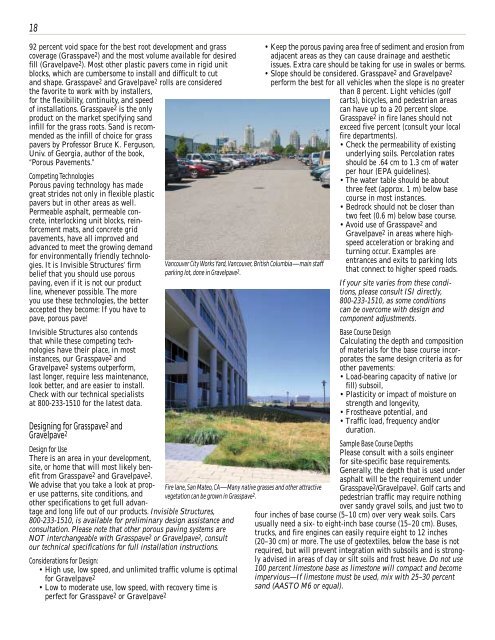Invisible Structures, Inc. - Houston Advanced Research Center
Invisible Structures, Inc. - Houston Advanced Research Center
Invisible Structures, Inc. - Houston Advanced Research Center
Create successful ePaper yourself
Turn your PDF publications into a flip-book with our unique Google optimized e-Paper software.
18<br />
92 percent void space for the best root development and grass<br />
coverage (Grasspave 2) and the most volume available for desired<br />
fill (Gravelpave 2). Most other plastic pavers come in rigid unit<br />
blocks, which are cumbersome to install and difficult to cut<br />
and shape. Grasspave 2 and Gravelpave 2 rolls are considered<br />
the favorite to work with by installers,<br />
for the flexibility, continuity, and speed<br />
of installations. Grasspave 2 is the only<br />
product on the market specifying sand<br />
infill for the grass roots. Sand is recommended<br />
as the infill of choice for grass<br />
pavers by Professor Bruce K. Ferguson,<br />
Univ. of Georgia, author of the book,<br />
“Porous Pavements.”<br />
Competing Technologies<br />
Porous paving technology has made<br />
great strides not only in flexible plastic<br />
pavers but in other areas as well.<br />
Permeable asphalt, permeable concrete,<br />
interlocking unit blocks, reinforcement<br />
mats, and concrete grid<br />
pavements, have all improved and<br />
advanced to meet the growing demand<br />
for environmentally friendly technologies.<br />
It is <strong>Invisible</strong> <strong>Structures</strong>’ firm<br />
belief that you should use porous<br />
paving, even if it is not our product<br />
line, whenever possible. The more<br />
you use these technologies, the better<br />
accepted they become: If you have to<br />
pave, porous pave!<br />
<strong>Invisible</strong> <strong>Structures</strong> also contends<br />
that while these competing technologies<br />
have their place, in most<br />
instances, our Grasspave2 and<br />
Gravelpave2 systems outperform,<br />
last longer, require less maintenance,<br />
look better, and are easier to install.<br />
Check with our technical specialists<br />
at 800-233-1510 for the latest data.<br />
Designing for Grasspave 2 and<br />
Gravelpave 2<br />
Design for Use<br />
There is an area in your development,<br />
site, or home that will most likely benefit<br />
from Grasspave 2 and Gravelpave 2.<br />
We advise that you take a look at proper<br />
use patterns, site conditions, and<br />
other specifications to get full advantage<br />
and long life out of our products. <strong>Invisible</strong> <strong>Structures</strong>,<br />
800-233-1510, is available for preliminary design assistance and<br />
consultation. Please note that other porous paving systems are<br />
NOT interchangeable with Grasspave2 or Gravelpave 2, consult<br />
our technical specifications for full installation instructions.<br />
Considerations for Design:<br />
• High use, low speed, and unlimited traffic volume is optimal<br />
for Gravelpave 2<br />
• Low to moderate use, low speed, with recovery time is<br />
perfect for Grasspave 2 or Gravelpave 2<br />
Vancouver City Works Yard, Vancouver, British Columbia—main staff<br />
parking lot, done in Gravelpave 2.<br />
• Keep the porous paving area free of sediment and erosion from<br />
adjacent areas as they can cause drainage and aesthetic<br />
issues. Extra care should be taking for use in swales or berms.<br />
• Slope should be considered. Grasspave 2 and Gravelpave 2<br />
perform the best for all vehicles when the slope is no greater<br />
than 8 percent. Light vehicles (golf<br />
carts), bicycles, and pedestrian areas<br />
can have up to a 20 percent slope.<br />
Grasspave 2 in fire lanes should not<br />
exceed five percent (consult your local<br />
fire departments).<br />
• Check the permeability of existing<br />
underlying soils. Percolation rates<br />
should be .64 cm to 1.3 cm of water<br />
per hour (EPA guidelines).<br />
• The water table should be about<br />
three feet (approx. 1 m) below base<br />
course in most instances.<br />
• Bedrock should not be closer than<br />
two feet (0.6 m) below base course.<br />
• Avoid use of Grasspave 2 and<br />
Gravelpave 2 in areas where highspeed<br />
acceleration or braking and<br />
turning occur. Examples are<br />
entrances and exits to parking lots<br />
that connect to higher speed roads.<br />
If your site varies from these conditions,<br />
please consult ISI directly,<br />
800-233-1510, as some conditions<br />
can be overcome with design and<br />
component adjustments.<br />
Base Course Design<br />
Calculating the depth and composition<br />
of materials for the base course incorporates<br />
the same design criteria as for<br />
other pavements:<br />
• Load-bearing capacity of native (or<br />
fill) subsoil,<br />
• Plasticity or impact of moisture on<br />
strength and longevity,<br />
• Frostheave potential, and<br />
• Traffic load, frequency and/or<br />
duration.<br />
Sample Base Course Depths<br />
Please consult with a soils engineer<br />
for site-specific base requirements.<br />
Generally, the depth that is used under<br />
asphalt will be the requirement under<br />
Grasspave2/Gravelpave2. Fire lane, San Mateo, CA—Many native grasses and other attractive<br />
Golf carts and<br />
vegetation can be grown in Grasspave pedestrian traffic may require nothing<br />
over sandy gravel soils, and just two to<br />
four inches of base course (5–10 cm) over very weak soils. Cars<br />
usually need a six- to eight-inch base course (15–20 cm). Buses,<br />
trucks, and fire engines can easily require eight to 12 inches<br />
(20–30 cm) or more. The use of geotextiles, below the base is not<br />
required, but will prevent integration with subsoils and is strongly<br />
advised in areas of clay or silt soils and frost heave. Do not use<br />
100 percent limestone base as limestone will compact and become<br />
impervious—If limestone must be used, mix with 25–30 percent<br />
sand (AASTO M6 or equal).<br />
2.
















